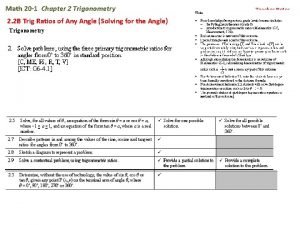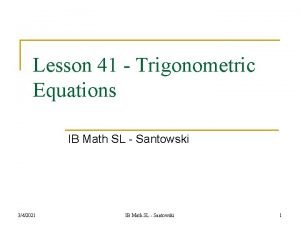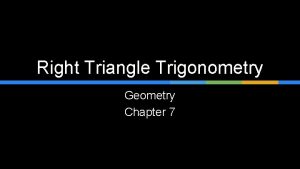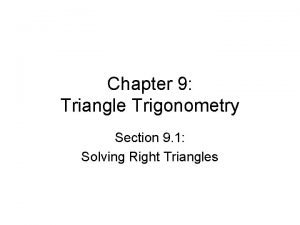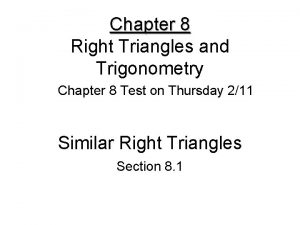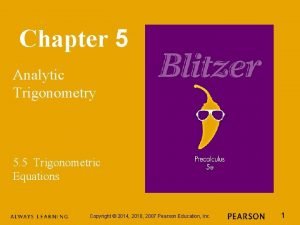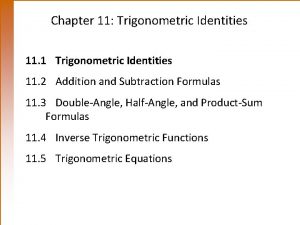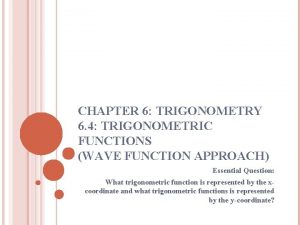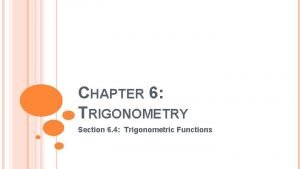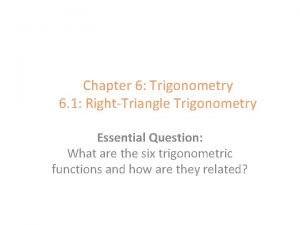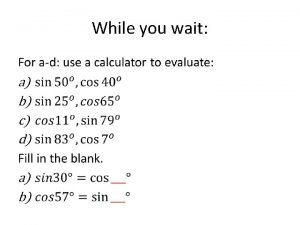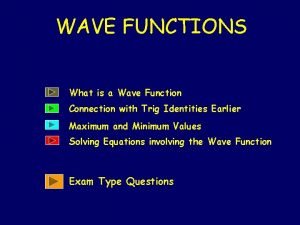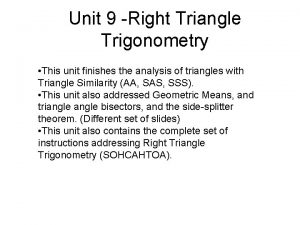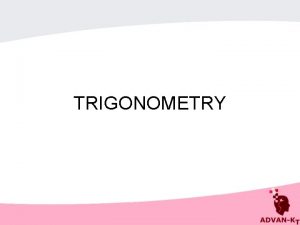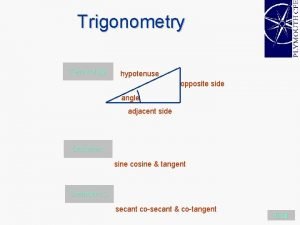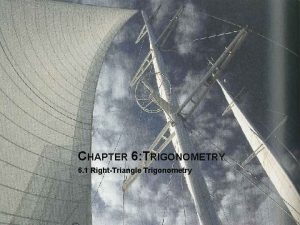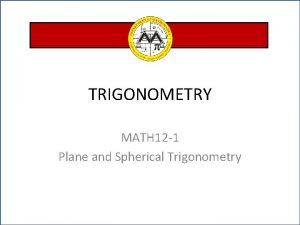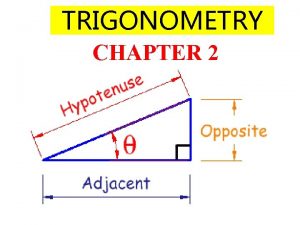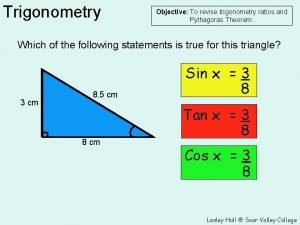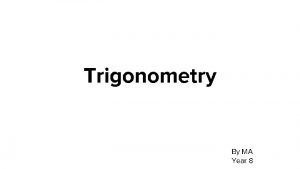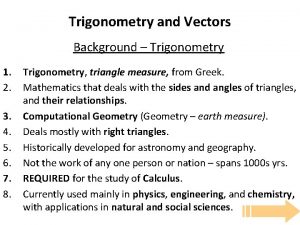Math 20 1 Chapter 2 Trigonometry 2 1















- Slides: 15

Math 20 -1 Chapter 2 Trigonometry 2. 1 B Angles in Standard Position Teacher Notes

Math 20 -1 Chapter 1 Sequences and Series 2. 1 B Angles in Standard Position Exact Values Upload flash file of Angles in Standard Position from Section 2. 1 of Digital Resources created by Mc. Graw – Hill Ryerson Pre-Calculus 11 2. 1. 1

Chapter Angles in Standard Position Identify the angles sketched in standard position. Check answer 2. 1. 2

Torso Angle - Fast Torso angle is very dependent upon the cyclists choice of performance and comfort. A lower position is more aerodynamic as frontal surface area is reduced. 30° to 40° is a good compromise of performance and comfort but does rely on reasonably good flexibility to lower back and hamstrings. Torso Angle - Touring A more relaxed torso angle will take the pressure off the lower back, hamstrings and the neck and distribute loads from hands to seat. 40° to 50° is a suitable angle for longer distances where comfort is the priority over speed. 2. 1. 3

Reference Angles Determine the measure of the reference angle. Angle in Standard Position (θ) 165° 320° 250° 60° Reference Angle (θR) Quadrant 85° 46° 37° 52° III I IV II Quadrant Reference Angle (θR) II IV III 15° 40° 70° I 60° Angle in Standard Position (θ) 265° 46° Determine the measure of the angle in standard position. 323° 128° 2. 1. 4

A ship is sailing in a direction given by the bearing N 35°E. Sketch the angle. 35° 55° What is the measure of the angle in standard position? 55° What is the measure of the reference angle of the angle in standard position? 55° 2. 1. 5

Trigonometry compares the ratios of the sides in a right triangle. The Primary Trigonometric Ratios. gle site O o pp an the There are three primary trig ratios: Opposite the right-angle sine cosine tangent Next to the angle 1 2 30º 2. 1. 6

Trig Equations sin 30º= trig function 300 angle trig ratio Knowing the measure of the reference angle, can you label the triangle? 2. 1. 7

Exact Values for Trig Ratios of Special Angles 300 - 600 - 900 600 2 2 600 c 2 = a 2 + b 2 2 2 = a 2 + 1 2 2 2 - 1 2 = a 2 √ 3 = a 300 2 600 2 1 450 -900 1 c 2 = a 2 + b 2 = 12 + 12 =2 c=√ 2 450 1 2. 1. 8

Exact Values of Trig Ratios 2. 1. 9

Angle 30° 150° 210° 330° Quadrant Sin I II Cos Tan III IV What do the angles have in common? What do notice about the ratios of the lengths of sides? Make a conjecture to determine the sign of the trig ratio for each quadrant. 2. 1. 10

Use your conjecture to determine the sign of the trig ratio for each quadrant. Angle 60° 120° 240° 300° Angle 45° 135° 225° 315° Quadrant Sin Cos Tan I II IV Quadrant Sin I II IV 2. 1. 11

Mc. Graw-Hill Ryerson Precalculus 11 Page 82 Example 4 Calculate the horizontal distance to the midline, labeled a. a 10 Which trig ratio would you use to determine the length of side a? The exact horizontal distance is 10 cm. 60° a 2. 1. 12

Using Exact Values Homework State the value of each ratio. 1. sin 300 = 3. tan 450 = 5. sin 1500 = RA = 300 7. tan 1350 = RA = 450 9. sin 1350 = RA = 450 2. cos 450 = 4. sin 600 = 6. cos 1200 = RA = 600 8. tan 1200 = RA = 600 10. cos 1500 = RA = 300 2. 1. 14

Assignment Suggested Questions Page 83: 8, 9, 13, 16, 17 b, 24 a, b 2. 1. 15
 Math 20-1 trigonometry review
Math 20-1 trigonometry review Sl 2021
Sl 2021 Hit the button
Hit the button Chapter 7 right triangles and trigonometry answer key
Chapter 7 right triangles and trigonometry answer key Chapter 9 right triangles and trigonometry
Chapter 9 right triangles and trigonometry Chapter 8 right triangles and trigonometry answer key
Chapter 8 right triangles and trigonometry answer key Analytic trigonometry calculator
Analytic trigonometry calculator What are the 11 trigonometric identities?
What are the 11 trigonometric identities? Evaluating the six trigonometric functionsassignment
Evaluating the six trigonometric functionsassignment Sin cos tan finger
Sin cos tan finger Trigonometry
Trigonometry How to simplify trig expressions
How to simplify trig expressions Satc trigonometry
Satc trigonometry Unit 9 right triangles and trigonometry answers
Unit 9 right triangles and trigonometry answers Cos² 45ᵒ + 2 . cos 60ᵒ + sin² 45ᵒ adalah
Cos² 45ᵒ + 2 . cos 60ᵒ + sin² 45ᵒ adalah Sin cos ran
Sin cos ran
